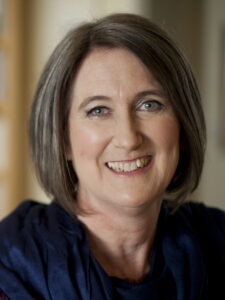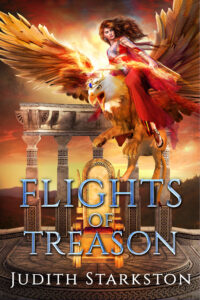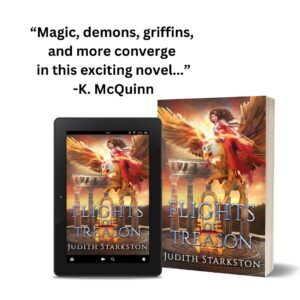Interview with Judith Starkston, author of Flights of Treason
 Today I’m welcoming writer Judith Starkston to answer some questions about the intoxicating blend of history and fantasy she’s created in her four book Tesha series set in the Bronze Age world of the Hittites.
Today I’m welcoming writer Judith Starkston to answer some questions about the intoxicating blend of history and fantasy she’s created in her four book Tesha series set in the Bronze Age world of the Hittites.
Let me start by asking who are the Hittites, and how did you come to set your fiction in their world?
The Hittites are the empire that history forgot—until somewhat recently when archaeologists dug them out. From about 1650 to 1200 BCE, they were a powerful part of the ancient world of Mesopotamia, Egypt, and the Mycenean Greeks. Their empire spread over what is today Turkey, Syria, and Lebanon. During the period of the empire in which I set my fiction, Ramses II of Egypt (of Moses fame) was their primary enemy.
I became intrigued with Hittites by way of writing a novel set in the Trojan War (Hand of Fire). It turned out that the answer to “Who were the Trojans?” had changed dramatically since I’d been a grad student studying classics. Enough archaeology had come to light that we now know that Troy was part of this Hittite world, sometimes as a vassal state, sometimes as an independent but culturally related city-kingdom. So, I had to figure out who the Hittites were, and I loved what I discovered. Most particularly, I learned of their most celebrated ruler, a queen named Puduhepa who ruled for decades over this giant empire. She and her husband had a famously equal partnership as rulers (and later her son who might not have been so thrilled to share with mom). Reading her extant letters and treaties (preserved as cuneiform tablets) showed me a powerful woman skilled at diplomacy, truth-seeking, and complex family dynamics. She had a fine, legalistic mind, a tendency to ocd-like precision, and a big streak of determination. She was also a mystic who had dream visions sent by the goddess Ishtar (Ishana in my books), whose priestess she was. I wanted to bring this woman out of the shadows of forgotten history by writing her into an entertaining but historically grounded series. I often say if she hadn’t been buried by the sands of time, she’d be as much a household name as Cleopatra or Elizabeth I.
By the way, there are Hittites mentioned in the Bible. These are a later, much smaller and less powerful group of people scholars now call neo-Hittites. A bit like one small town on one edge of the U.S. calling itself “America” if the U.S. had collapsed and been forgotten.
You describe your series as historical fantasy. How did the fantasy part come to be?
The historically known story of this woman, who in my series is called Tesha (the Hittite word for dream), begins when as a young priestess she met the younger brother of the Great King (which was the formal title of the Hittite emperor). We know they got married shortly after this meeting, and we know that around this time he was accused of sorcery and this court case was the second he had faced in his life. As a priestess, she practiced rites that we would call magic, such as removing curses. The Hittites were obsessed with the threat of curses and how to cleanse such evil pollution and stow it away in the Underworld.
As I wrote about this mixture of magic, romance, murder mystery, and royal power, I realized that letting happen whatever magic or sorcery these people thought was real, would make a far more engaging story. That meant writing fantasy, although the rules of the magic in my novels start with Hittite concepts and beliefs.
The series opens in the first book (Priestess of Ishana) with Tesha as a reluctant user of such magic, but the fantastical elements and her skills and sorcerous foes become more expansively fantastic as the series progresses to the fourth and final book, Flights of Treason. I also incorporated the fantastical beasts, griffins, who are depicted widely in Hittite art. This combination of history and fantasy is very fun to write, and I hope to read!
Why did a book reviewer say, “What George R.R. Martin’s Game of Thrones did for the War of the Roses, Starkston has done for the forgotten Bronze Age Hittite civilization.”
While my fiction is less violent and more positive in its presentation of women than Martin’s, I was flattered by this comparison drawn by Amalia Carosella, who is, by the way, an outstanding author of fiction set in Greek mythology. Martin is a master writer on so many levels that surpass my skills, but I’m guessing she meant that I’ve taken an obscure period in history and immersed my readers in it along with a generous measure of royal treachery, power plays, and fantastical beasts. The skeleton of my series’ plot structure arises from actual events during which the Hittite throne changed hands more than once and external enemies pushed in openly and secretly (lots of spies and conspiracies). I am careful to make my world-building as accurate as our knowledge of this culture permits, even while I’ve got truly fantastical elements like building-sized griffins. I’ve tried to do for griffins somewhat as Martin did with his dragons by creating the mythology of their origins and interactions with people over time. My griffins communicate telepathically, so they are fully developed characters emotionally to the reader, but they are definitely not human. That is challenging to write but a blast. I will say that while I occasionally kill off characters, I’m much less vicious in this regard than Martin!
 In my series, Tesha is a young woman making many mistakes and only gradually coming into her understanding of how to rule well and be an admirable female leader. I hope she wins a place in readers’ hearts as she has in mine.
In my series, Tesha is a young woman making many mistakes and only gradually coming into her understanding of how to rule well and be an admirable female leader. I hope she wins a place in readers’ hearts as she has in mine.
Thank you, Judith, for that introduction to your books.
You can find the four books of the Tesha series, along with a griffin novella, on the Amazon Tesha series page.
On Judith’s website you’ll find more about her books, their historical background, and a place to sign up for her newsletter (and get the griffin novella free).



